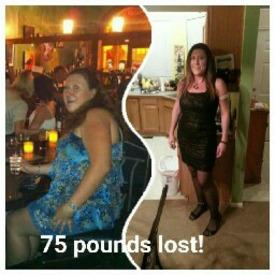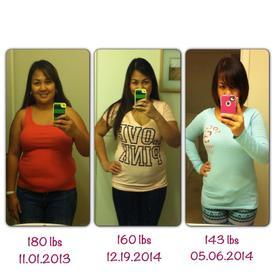HELP!!! Do you weigh your meat cooked or uncooked?
Replies
-
I'm also really struggling with this. I got a food scale for Christmas, and all it's done is make me frustrated/confused :mad:
Also, if I put a tbsp of olive oil in the pan to cook my chicken, obviously I'm eating some of that oil, but the majority is left in the pan when I remove the chicken. I still enter the tbsp of oil, but it sucks to have such calorie dense entries (that I'm not really eating) taking up valuable calories for the day.
I'm taking the approach that it's best to err on the side of caution, and just assume the worst/highest numbers, until my weight gets down, but that also makes it less sustainable (for me, personally, because all this weighing and whatnot is really sucking the fun out of preparing meals).
So...have we settled on raw weight then?0 -
I guess I'm not too hardcore. I don't need my numbers to be so specific as to matter whether I weighed raw or cooked.
Depending on how I prepare depends on when I weigh. It's close enough for government work.0 -
Raw/uncooked.0
-
I'm surprised that most people here are saying to weigh it uncooked. I'm not a meat eater, so I'm no expert, but I do eat fish. I know that when I defrost shrimp, they weight significantly less than when they are frozen- and on the package the nutrition is given when they are de-thawed. Obviously, they loose water weight in the dethawing process. However, surely, after meat is cooked (especially on the BBQ) it has lost a significant amount of fat and calories. You aren't eating all of the fat located in the meat before it's grilled, as lots of it is lost in the cooking process (grilling). Again, I don't eat meat, but I think that weighing it when it's cooked is most effective.
Rice confuses the hell out of me, I just go with what's on the package and go by that measurement (dry).
How do they lose water dethawing? I could see thawing but dethawing just doesn't make sense.:drinker:0 -
Uncooked0
-
I weigh it uncooked.0
-
I'm surprised that most people here are saying to weigh it uncooked. I'm not a meat eater, so I'm no expert, but I do eat fish. I know that when I defrost shrimp, they weight significantly less than when they are frozen- and on the package the nutrition is given when they are de-thawed. Obviously, they loose water weight in the dethawing process. However, surely, after meat is cooked (especially on the BBQ) it has lost a significant amount of fat and calories. You aren't eating all of the fat located in the meat before it's grilled, as lots of it is lost in the cooking process (grilling). Again, I don't eat meat, but I think that weighing it when it's cooked is most effective.
Rice confuses the hell out of me, I just go with what's on the package and go by that measurement (dry).
Thawed does not mean cooked.. I weigh my meat after it thaws but prior to cooking. If the calories given is based on raw weight, that that is what you need to use.0 -
Uncooked is more accurate...I once reduced a chicken breast from ~12 ounces to ~8 ounces by cooking it...if weighed cooked, my calories would have been way off.
I do think consistency is key. If you want to be wrong ( ) and weigh your food cooked, at least do it that way consistently. I think what you'll find though is that you need to eat "less" calories to lose weight. By lowering your calorie goal (based on real world results) you are effectively negating the extra calories you are eating. 0
) and weigh your food cooked, at least do it that way consistently. I think what you'll find though is that you need to eat "less" calories to lose weight. By lowering your calorie goal (based on real world results) you are effectively negating the extra calories you are eating. 0 -
All food uncooked.
When in school, we burned a peanut as fuel to heat water to determine the energy it contained (and so determined the calorific value). In labs where they determine the calories in food, they do pretty much the same.
(To heat 1 ml water by 1*C, it takes 1 Joule, I think, from memory)0 -
Also, if I put a tbsp of olive oil in the pan to cook my chicken, obviously I'm eating some of that oil, but the majority is left in the pan when I remove the chicken. I still enter the tbsp of oil, but it sucks to have such calorie dense entries (that I'm not really eating) taking up valuable calories for the day.
If you want to go for more accuracy with the oil you use, you could measure the leftover oil in the pan and subtract that from 1 TBSP to get the actual value. It probably doesn't matter much for 1 TBSP, but I have oven fried some things in 3 or 4 tbsp. of oil, and when more than 1/2 the oil is left, I don't want to have the recipe calorie count be that far off.
If you always have lots of oil left over, you could also start with 1 tsp, and only add more if needed while cooking...0 -
If I eat it raw. I weigh it raw.
If I eat it cooked, then I weigh it after cooking.0 -
I keep finding mixed answers on this topic, most of them from forums and no real source. So, I read up on the law that made grocers list nutrition facts on MEAT labels. It turns out that the serving size and nutrition info labelled is for RAW, purchased food NOT cooked. Meaning that if the label says, "Serving size: 4 oz; Calories: 170," it means that in 4 oz of RAW meat there is 170 calories.
Using the above measurements, if you take a RAW steak that weighs 6 oz and cook it, it now weighs 4 oz. However, this DOES NOT mean the serving size is the entire steak, because it originally weighed 6 oz. If you eat the whole 4 oz cooked steak you are consuming 1.5 servings which is 255 calories.
The law requires the measurements to be taken RAW because everyone cooks differently. I know this SUCKS because you end up with less food, but hey.... that's dieting isn't it?? It also makes it hard if you order food.
Sources:
http://www.eatright.org/Public/content.aspx?id=6442470039
http://www.fsis.usda.gov/wps/portal/fsis/topics/regulatory-compliance/labeling/labeling-policies/nutrition-labeling-policies/nutrition-labeling
http://www.fsis.usda.gov/wps/wcm/connect/7ba62a63-64a6-4fda-a709-6d71d0b339c4/Nutrition_Labeling_Overview.pdf?MOD=AJPERES
Edit: No HTML or links in this forum...:-/ Take my word or copy/paste0 -
Cooked! It's the weight that you are actually putting into your body that counts, raw or uncooked weight is meaningless! It's very important to accurately weigh the quantity that you are consuming and don't use the weight stated on the package.
That's what I do!0 -
But this is wrong, because the nutritional information is for raw, which means when it's cooked and weighs less you are underestimating your calories.Cooked! It's the weight that you are actually putting into your body that counts, raw or uncooked weight is meaningless! It's very important to accurately weigh the quantity that you are consuming and don't use the weight stated on the package.
That's what I do!0 -
If you weigh it raw, and it loses water when cooked, then aren't you weighing the water? I can't imagine the water it loses contains the protein and nutrients you hope to absorb, so would you not be inaccurate on what you estimate? Just as an example, you weigh 10 oz of raw chicken, and 3 oz of it is water, then you would be overestimating 90 calories or so, plus 15g of protein? Sounds like weighing raw is weighing the water and calling it something its not.0
-
No. Calorie and nutritional content are based on the raw product weight, which includes the water. 4 oz of raw chicken will have a completely different nutritional profile than 4 oz of cooked chicken. Also, due to variances in water loss when cooking, it's impossible to guess what the cooked weight of any raw product will be when it's done cooking.
This is why restaurants always advertise "precooked weight" when they talk about a 4 oz burger patty, or a 10 oz steak; it's impossible for them to give an accurate weight after it's cooked, because it will vary.0 -
Always cooked.
Raw food contains a lot of water & ice (if frozen). And I want true MEAT only measurements, not water and ice.0 -
It is fine to weigh food before you eat it if it is steak or children breast but what if it is a roast or turkey. Pretty hard to weigh it then.0
-
If you weigh it cooked then how do you determine the nutritional content? Eg. two people could each start off with 200g chicken breast and cook it for two different times, say one ends up being 150g and the other 120g. Theoretically, they should have the same protein content if all they lose is water, so surely you need to go by the raw weight otherwise you'd attribute two different protein amounts to each chicken breast?
However, my issue is how to determine the values in the raw weight when nutritional data is given "as cooked per instructions". Eg. I make an omelette bake for my breakfasts using 500g raw lean turkey breast mince. The nutritional values are given "as cooked per instructions", which is something like shallow fry for 5 mins on a medium heat. So how do I make sure I'm recording values correctly if I don't cook as per the instructions?
I've scanned the barcode on the turkey mince into myfitnesspal and it brings up the values as cooked per instructions but for 500g, which seems to suggest I'm overstating the protein content etc of my meal?
Do we need to cook as per instructions, weigh it and attribute this back to the 500g raw? In which case, the data on myfitnesspal when you scan the barcode for meat will be inaccurate!0 -
If you weigh it cooked then how do you determine the nutritional content? Eg. two people could each start off with 200g chicken breast and cook it for two different times, say one ends up being 150g and the other 120g. Theoretically, they should have the same protein content if all they lose is water, so surely you need to go by the raw weight otherwise you'd attribute two different protein amounts to each chicken breast?
However, my issue is how to determine the values in the raw weight when nutritional data is given "as cooked per instructions". Eg. I make an omelette bake for my breakfasts using 500g raw lean turkey breast mince. The nutritional values are given "as cooked per instructions", which is something like shallow fry for 5 mins on a medium heat. So how do I make sure I'm recording values correctly if I don't cook as per the instructions?
I've scanned the barcode on the turkey mince into myfitnesspal and it brings up the values as cooked per instructions but for 500g, which seems to suggest I'm overstating the protein content etc of my meal?
Do we need to cook as per instructions, weigh it and attribute this back to the 500g raw? In which case, the data on myfitnesspal when you scan the barcode for meat will be inaccurate!
Two options that are probably not the best: log as is and hope you do minimal damage, especially if you do this infrequently enough. Option #2 has you limiting or steering clear of items that can be hard to calorie count. I had my fill of deep fried chicken strips to satisfy a craving I had for a while, but nowadays I don't even want to deal. Need someone smart to figure this stuff out, stat!0 -
I've just been reading another post, which is the same issue - http://www.myfitnesspal.com/topics/show/1276168-cooked-vs-uncooked-confused
I think the way forward may be to cook as per instructions, weigh it and convert back to the raw weight, or find something similar which gives raw values. Otherwise I'm overstating in my diary and not eating as much as I want (I'm trying to bulk btw so trying to create a calorie surplus!)0 -
If you are dieting to lose weight it would make alot more sense to weigh before cooking.. In my opinion it's better to over estimate what your eating then underestimate and end up going over your daily intake allowance.0
-
If you are going to eat it raw then weigh it raw, if you are going to eat it cooked weigh it cooked. There is a difference for a given weight, for example, assuming the USDA Nutrition tables are correct.
http://ndb.nal.usda.gov/ndb/foods
Beef, top sirloin, steak, separable lean and fat, trimmed to 1/8" fat, all grades,
Nutrient Unit Broiled Value per 100 g Raw Value per 100 g
Water g 58.36 66.09
Energy cal 243 201.0
Protein g 26.96 20.3
Total lipid (fat) g 14.23 12.71
Fatty acids, total saturated g 5.603 5.127
Fatty acids, total monounsaturated g 5.93 5.44
Fatty acids, total polyunsaturated g 0.547 0.483
Carbohydrate, by difference g 0 0
Fiber, total dietary g 0 0
Sugars, total g 0 0
Calcium, Ca mg 20 24
Iron, Fe mg 1.73 1.480 -
People are getting mixed up with cooked/uncooked when they needn't be.
All you need to do if you weigh your food AFTER cooking is make sure you enter the cooked value. If you weigh it raw then make sure the raw values are used! Why is this so difficult? Just be consistent with your method and you won't tangle yourself up.
In the example of chicken, if you cook it and it now weighs 4oz, but you select the raw data by mistake, you'll be under reporting your macros. Reason being is that 4oz of cooked chicken was probably 5oz raw. The nutritional data for 4oz raw chicken and 5oz raw chicken is obviously going to be different!0 -
Always Raw weight here...... :drinker:0
-
People are getting mixed up with cooked/uncooked when they needn't be.
All you need to do if you weigh your food AFTER cooking is make sure you enter the cooked value. If you weigh it raw then make sure the raw values are used! Why is this so difficult? Just be consistent with your method and you won't tangle yourself up.
In the example of chicken, if you cook it and it now weighs 4oz, but you select the raw data by mistake, you'll be under reporting your macros. Reason being is that 4oz of cooked chicken was probably 5oz raw. The nutritional data for 4oz raw chicken and 5oz raw chicken is obviously going to be different!
Yep.
And if I precook 2 or 3 chicken breast and cut into chunks, or get split breast and cook and debone to use all week, how am I going to weigh that raw. I just look for the food log to tell me....baked, fried, raw...whatever my case may be at the time.0 -
I have been doing cooked all along. But then I overestimate calories eaten and underestimate calories burned as a habit so I think it evens out for me.
I think if you are consistent in whichever method you choose, you should do fine.0 -
People are getting mixed up with cooked/uncooked when they needn't be.
All you need to do if you weigh your food AFTER cooking is make sure you enter the cooked value. If you weigh it raw then make sure the raw values are used! Why is this so difficult? Just be consistent with your method and you won't tangle yourself up.
In the example of chicken, if you cook it and it now weighs 4oz, but you select the raw data by mistake, you'll be under reporting your macros. Reason being is that 4oz of cooked chicken was probably 5oz raw. The nutritional data for 4oz raw chicken and 5oz raw chicken is obviously going to be different!
Yep.
And if I precook 2 or 3 chicken breast and cut into chunks, or get split breast and cook and debone to use all week, how am I going to weigh that raw. I just look for the food log to tell me....baked, fried, raw...whatever my case may be at the time.
Right. The only problem I see is if someone weighs it cooked and uses the raw (or package) information. Then you are undercounting by a significant amount.
But on the whole just use the correct entry and it doesn't matter much.0 -
Initially, I do both. I weigh it raw and then I cook it and weigh it again. Then I make an entry under My Foods with the weight it was cooked yielding from the weight it was raw. That way, I can confidently cook the meat without weighing before every time because I already know what a serving will weigh. i do the same thing with pasta.0
-
It is fine to weigh food before you eat it if it is steak or children breast but what if it is a roast or turkey. Pretty hard to weigh it then.
LOL @children breast0
This discussion has been closed.
Categories
- All Categories
- 1.4M Health, Wellness and Goals
- 398.3K Introduce Yourself
- 44.7K Getting Started
- 261K Health and Weight Loss
- 176.4K Food and Nutrition
- 47.7K Recipes
- 233K Fitness and Exercise
- 462 Sleep, Mindfulness and Overall Wellness
- 6.5K Goal: Maintaining Weight
- 8.7K Goal: Gaining Weight and Body Building
- 153.5K Motivation and Support
- 8.4K Challenges
- 1.4K Debate Club
- 96.5K Chit-Chat
- 2.6K Fun and Games
- 4.7K MyFitnessPal Information
- 17 News and Announcements
- 21 MyFitnessPal Academy
- 1.5K Feature Suggestions and Ideas
- 3.2K MyFitnessPal Tech Support Questions
























